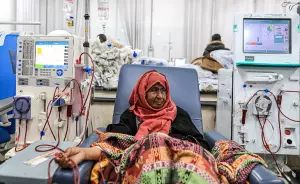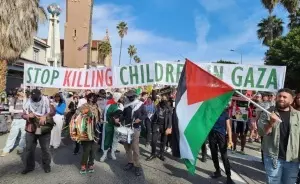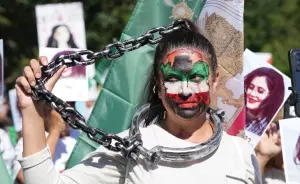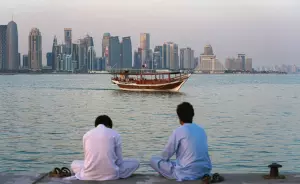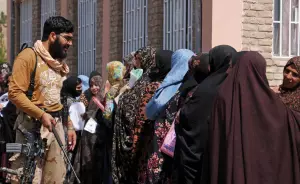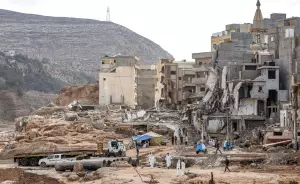- Huwaida Arraf
- 2003 May
- Posted On
Washington Report on Middle East Affairs, May 2003, pages 12-13
Special Report
Rachel Corrie (1979-2003): An American Martyr for Palestine
By Huwaida Arraf
“I really can’t believe that something like this can happen in the world without a bigger outcry about it. It really hurts me, again, like it has hurt me in the past, to witness how awful we can allow the world to be.”
—Excerpt from Rachel’s e-mail to her mother on Feb. 27, 2003 describing the situation in Gaza.
Our friend and fellow activist for peace, Rachel Corrie, 23 years old, was crushed to death on Sunday, March 16, when she was run over by an Israeli-driven, U.S.-made Caterpillar D9 bulldozer. She, nonviolently, was trying to prevent the Israeli military from demolishing a Palestinian doctor’s home in the Rafah area of the Gaza Strip.
Rachel was in Rafah as a volunteer with the International Solidarity Movement (ISM), a Palestinian-led movement of both Palestinians and internationals working together for an end to the Israeli occupation of Palestine. The ISM uses nonviolent, direct-action methods and principles to challenge and resist Israel’s brutal 36-year military occupation of the West Bank and Gaza, and to campaign for the implementation of U.N. resolutions and international law.
In response to the international community’s failure to offer Palestinians an international protection force, Rachel Corrie and other ISM activists actively have confronted Israel’s policy of home demolition, and international apathy toward this policy, by living with families whose homes are threatened and by refusing to leave them, or areas threatened with demolition. The ISM believes that its presence slows the process of destruction and hopes that the international community ultimately will act to support the daily nonviolent struggle of normal Palestinian families to exist.
Demolishing civilian homes is an act of genocide that violates Articles 12 and 25 of the Universal Declaration of Human Rights and Articles 33, 53, and 54 of the Fourth Geneva Convention. Despite this clear international prohibition, the Israeli military government has carried out thousands of demolitions with impunity, leaving thousands of innocent Palestinian families without basic shelter. All have experienced a cataclysmic blow to their lives, and some have become refugees for the second or third time in their lives.
Demolition-caused deaths, moreover, are far too common. On Dec. 2, 2002, 68-year-old Ashur Salem, who was deaf, was crushed to death when the Israeli army dynamited his home while he was sleeping. On Feb. 6, 2003, 65-year-old Kamla Abu Said, partially deaf, also was crushed to death when the Israeli army razed her Gaza home. On Feb. 19, brothers Said and Ala Heloo were killed when the Israeli army blew up a nearby building, causing their home to collapse on them. And less than two weeks before Rachel’s killing, on March 3, 2003, 33-year-old Nuha Sweidan—nine months into her pregnancy—was crushed to death when the Israeli military dynamited an adjacent home, causing her own home to collapse on top of her.
On the day Rachel was killed, she and fellow ISM activist Greg Schnabel were at a water well in the Tel el-Sultan area of the Gaza Strip, trying with their presence to protect the well, and the municipal workers trying to repair it, from destruction by the Israeli army. At approximately 2 p.m. Rachel and Greg received a call from other ISM volunteers, who told them that two bulldozers and a military tank had been spotted in the Haiy el-Salaam neighborhood, and that they needed backup if these bulldozers were going to carry out large-scale destruction of the area, as was expected. Rachel and Greg left Tel el-Sultan to join the others.
For approximately two hours, beginning around 3 p.m., eight international peace activists tried to prevent the soldiers operating the bulldozers from demolishing Palestinian land and property. They did this by engaging the soldiers and letting them know that their actions were a violation of international law and could be considered war crimes; they physically blocked the Israelis’ work by sitting and standing on areas that the bulldozers were trying to destroy. One of the bulldozers began to work near the house of a physician who was a friend of the ISM team, and in whose house Rachel and other activists often stayed. While the other activists occupied other structures in the area, Rachel sat down in the pathway of the bulldozer coming at the physician’s home. Initially about 10 to 15 meters away from the bulldozer, and in a florescent orange jacket, Rachel was clearly visible to the bulldozer driver—and she did not move. The Israeli soldier driving it, however, kept moving forward. As it became obvious that he was not stopping, Rachel stood up on top of a mound of dirt and rubble to look the driver in the eye. He kept moving forward, scooping up the dirt and rubble—which knocked Rachel over, and buried her. Despite the screams of the other internationals, the soldier continued to drive over Rachel’s body. After a few seconds, he reversed the bulldozer, without lifting the blade—effectively running over Rachel again—before he retreated.
As Rachel’s friends and colleagues ran to dig out her broken body and administer first aid, Rachel cried: “My back is broken!”
An army tank approached the area where the volunteers were desperately trying to stabilize Rachel as they held her, waiting for an ambulance. A soldier looked out of the tank, and one of the volunteers shouted that their friend had been run over. The soldier did not respond, and the tank retreated without offering assistance. A Palestinian ambulance arrived approximately 15 minutes later, and the internationals shielded the Palestinian medics who lifted Rachel onto the stretcher and put her into the ambulance.
The trauma to Rachel’s body was too severe, however, and at approximately 5:20 p.m. doctors at Rafah’s al Najjar Hospital pronounced Rachel dead of “skull and chest fractures.”
LOVE AND SOCIAL JUSTICE
“....I think about the fact that no amount of reading, attendance at conferences, documentary viewing and word of mouth could have prepared me for the reality of the situation here. You just can’t imagine it unless you see it, and even then you are always well aware that your experience is not at all the reality: what with the difficulties the Israeli army would face if they shot an unarmed U.S. citizen, and with the fact that I have money to buy water when the army destroys wells, and, of course, the fact that I have the option of leaving. Nobody in my family has been shot, driving in their car, by a rocket launcher from a tower at the end of a major street in my hometown. I have a home. I am allowed to go see the ocean....”
—Excerpt from Rachel’s e-mail to family and friends about the situation in Gaza, Feb. 7, 2003
At the young age of 23, Rachel was an extremely conscientious person, full of love and a strong sense of social justice. Her friends and colleagues in her hometown of Olympia, Washington recall how Rachel “poured her life and energy into her local and global community. She consistently worked to establish connections between various groups working for justice. As an Olympia native she was known and loved by so many; her work was focused on bringing together the labor, human rights, environmental and artistic communities. With creativity and joy, she made everyone feel special and blessed to know her. We are amazed by her fortitude, wisdom, passion and humility. We carry on her spirit, new flames alight, as we demand peace and justice in Rachel’s name.”
Rachel believed in making this world a smaller place by forging relationships between people and communities. In the Gaza Strip she was not only volunteering with the International Solidarity Movement, but also working on developing a sister-city relationship between Olympia and Rafah. She constantly sent e-mails home to her community in an effort to awaken them to the realities of Palestinian life. She wrote home that she thought “it is a good idea for us all to drop everything and devote our lives to making this stop. I don’t think it’s an extremist thing to do anymore. I still really want to dance around to Pat Benatar and have boyfriends and make comics for my co-workers. But I also want this to stop. Disbelief and horror is what I feel. Disappointment. I am disappointed that this is the base reality of our world and that we, in fact, participate in it. This is not at all what I asked for when I came into this world. This is not at all what the people here asked for when they came into this world. This is not the world you and Dad wanted me to come into when you decided to have me.”
Rachel put her life on the line to try to make the injustice stop. She literally put her body in front of a bulldozer to stand up against an inhuman and illegal policy. Rachel could not imagine that another human being into whose eyes she was looking would take her life, but he did. Ultimately, however, she was right in believing that she was more powerful than that bulldozer, because Rachel’s last stand has empowered the ISM and the Palestinian people to continue resisting abuse and injustice by standing in the face of it.
On March 25, 2003, Congressman Brian Baird (D-WA) introduced into committee H.Con.Res.111 calling for a U.S. investigation into Rachel’s death. Please ask your congressional representative to sign onto this resolution. The United States government thus far has refused to conduct an investigation into Rachel’s killing, satisfied with Israel’s assurance that it will investigate. The Israeli government already has swept this under the rug, however, claiming that it was an “accident” caused by Rachel’s “own carelessness.” The U.S. government has a particular responsibility to investigate Rachel Corrie’s death, not only because she was a U.S. citizen killed by a foreign military, but also because the U.S. actively supplies Israel with the military hardware and funds that enable it to carry out such illegal and murderous acts.
While we recognize that Rachel gave her life fighting Israel’s occupation and policy of home demolition, which aren’t addressed in Congressman Baird’s resolution, it is our hope that the passing of H.Con.Res.111 will open the door for these larger policies of violence against Palestinian civilians to be addressed. For it is Palestinians who put their lives on the line every day, just to live—and to resist a policy that is aimed at disposing of them.
RELATED LINKS:
International Solidarity Movement:
Rachel Corrie memorial Web site:
Huwaida Arraf is a co-founder of the International Solidarity Movement.
Top 10 articles in this category...
- Hits: 2087






